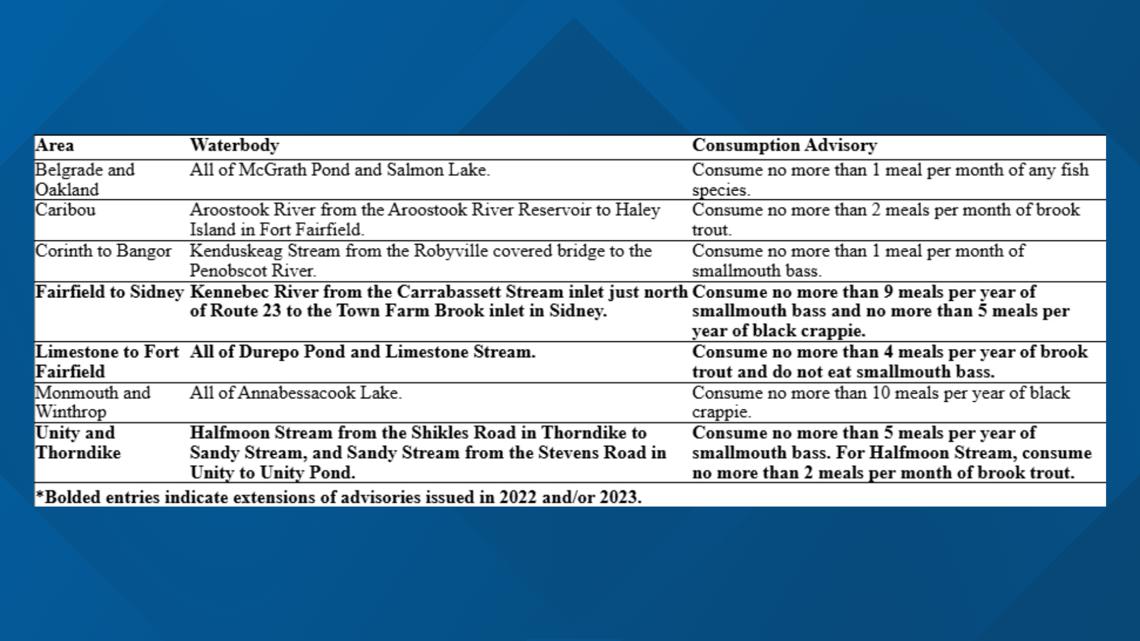MAINE, USA — The Maine Center for Disease Control (Maine CDC) issued an updated and additional freshwater fish consumption advisory Tuesday, due to elevated levels of PFAS found in waterbodies across the state.
Fish tested from these locations contained levels of per- and polyfluoroalkyl substances —known as PFAS—above the Maine CDC's recommended levels for regular consumption, according to a Tuesday release from the Maine Department of Health and Human Services.
Based on their findings, the Maine CDC is recommending individuals limit consumption of all or certain fish from the seven bodies of water listed below.
"Three of the advisories are expansions of those issued last year and four bodies of water are new additions. With these updates and additions, a total of 16 water bodies in Maine currently have a freshwater fish consumption advisory. All fish consumption advisories are listed on the Maine CDC’s website," the release stated.
The Maine CDC detected elevated levels of PFAs called perfluorooctane sulfonic acid (PFOS) in fish samples from the following bodies of water: McGrath Pond and Salmon Lake in Belgrade and Oakland, Aroostook River in Caribou, Kenduskeag Stream in Kenduskeag and Bangor, Kennebec River in Waterville, Limestone Stream in Fort Fairfield, Annabessacook Lake in Monmouth and Winthrop, and Sandy and Halfmoon Streams in Unity and Thorndike.
The new fish consumption advisories, listed below, apply to game fish caught in these waterbodies:


“These updates and expansions of Maine's fish consumption advisories are part of our broader work to limit Maine people's exposure to PFAS," Dr. Puthiery Va, director of the Maine CDC, stated in the release. “They are designed to protect the health of Maine anglers, their families and friends, and everyone who enjoys eating freshwater fish from these bodies of water.”
“Maine has over 32,000 miles of rivers and streams, and 6,000 lakes and ponds,” Judy Camuso, commissioner of the Maine Department of Inland Fisheries and Wildlife (MDIFW), said in a release. “This revised advisory provides Maine’s 360,000 anglers the information they need when choosing to have a meal of freshwater fish.”
While the Maine CDC said fishing, swimming, wading, and boating remain safe activities in these waterbodies, they recommend anglers review all existing fish consumption advisories for Maine waters.
"The Maine Department of Environmental Protection (DEP) collected and tested fish from these waterbodies for PFAS because they are located where historical PFAS contamination has been found in groundwater, surface water, and/or soils. The testing this year included testing of new waterbodies and expanded testing of waterbodies to better inform consumption advisories. The Maine CDC continually consults with the Maine DEP and MDIFW to develop plans for additional sampling of fish as part of the State’s ongoing investigation of PFAS," the release stated.
PFAS are man-made chemicals that are found in a variety of consumer products all over the world. Based on a report from the National Academies of Sciences, Engineering, and Medicine, exposure to certain PFAS chemicals has been associated with a variety of health issues, including changes in liver and kidney function, changes in cholesterol levels, decreased immune response to vaccines in children, complications during pregnancy, and increased risk of kidney cancer and possibly testicular cancer, according to the release.

